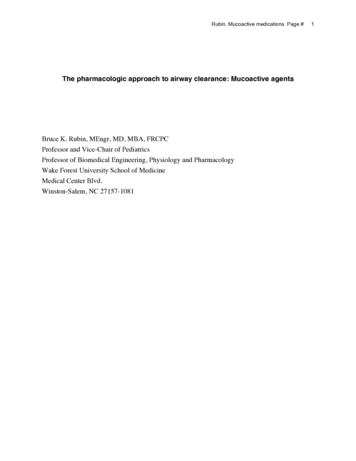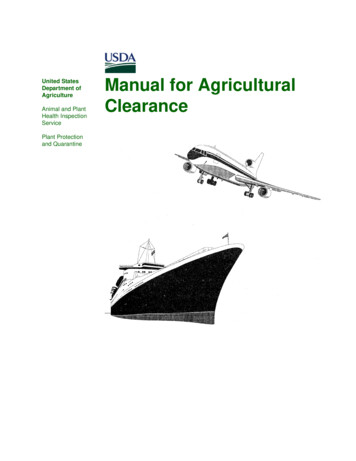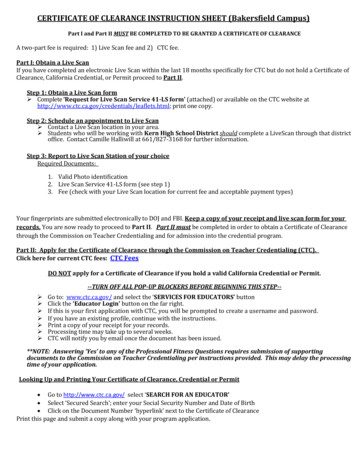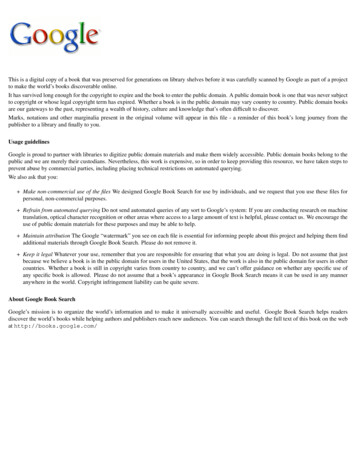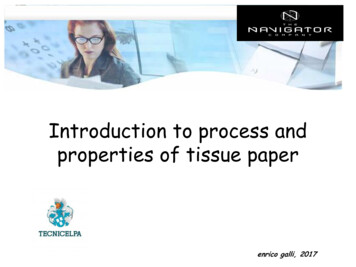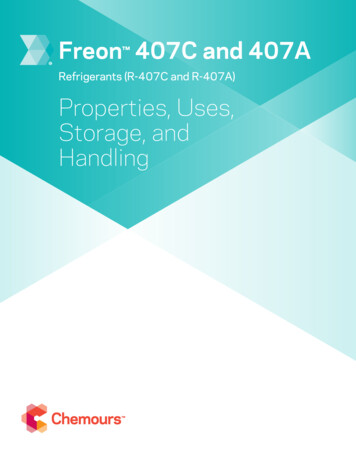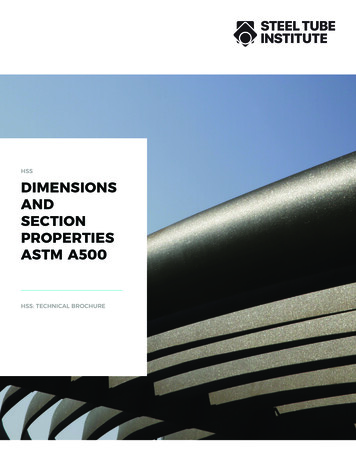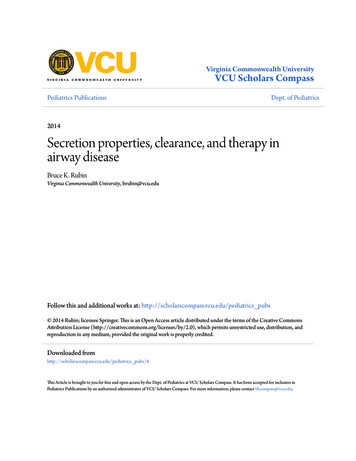
Transcription
Virginia Commonwealth UniversityVCU Scholars CompassPediatrics PublicationsDept. of Pediatrics2014Secretion properties, clearance, and therapy inairway diseaseBruce K. RubinVirginia Commonwealth University, brubin@vcu.eduFollow this and additional works at: http://scholarscompass.vcu.edu/pediatrics pubs 2014 Rubin; licensee Springer. This is an Open Access article distributed under the terms of the Creative CommonsAttribution License (http://creativecommons.org/licenses/by/2.0), which permits unrestricted use, distribution, andreproduction in any medium, provided the original work is properly credited.Downloaded fromhttp://scholarscompass.vcu.edu/pediatrics pubs/4This Article is brought to you for free and open access by the Dept. of Pediatrics at VCU Scholars Compass. It has been accepted for inclusion inPediatrics Publications by an authorized administrator of VCU Scholars Compass. For more information, please contact libcompass@vcu.edu.
Rubin Translational Respiratory Medicine 2014, Open AccessSecretion properties, clearance, and therapy inairway diseaseBruce K RubinAbstractChronic airway diseases like cystic fibrosis, chronic bronchitis, asthma, diffuse panbronchiolitis, and bronchiectasisare all associated with chronic inflammation. The airway mucosa responds to infection and inflammation in part bysurface mucous (goblet) cell and submucosal gland hyperplasia and hypertrophy with mucus hypersecretion.Products of inflammation including neutrophil derived DNA and filamentous actin, effete cells, bacteria, and celldebris all contribute to mucus purulence and, when this is expectorated it is called sputum. Mucus is usuallycleared by ciliary movement, and sputum is cleared by cough.These airway diseases each are associated with the production of mucus and sputum with characteristic composition,polymer structure, and biophysical properties. These properties change with the progress of the disease making itpossible to use sputum analysis to identify the potential cause and severity of airway diseases. This information has alsobeen important for the development of effective mucoactive therapy to promote airway hygiene.ReviewIntroductionMucus clearance is a primary defense mechanism of thelung. Mucus is a barrier to airway water loss and microbialinvasion and it is essential for the clearance of inhaled foreignmatter [1]. Mucus is a viscoelastic gel consisting of water andhigh molecular weight glycoproteins, called mucins, mixedwith serum and cellular proteins and lipids. The principalgel-forming mucins in the human airway are MUC5AC andMUC5B [2,3]. There are variable amounts of cell debris andparticulate matter in normal mucus. Sputum is expectoratedmucus mixed with inflammatory cells, cellular debris, DNAand F-actin, as well as bacteria [4] (Figure 1). In cystic fibrosis(CF), there is almost no intact mucin in the airway secretions[5] due to mucin degradation by serine proteases [6]. Thesesecretions are biochemically identical to pus.Respiratory mucus is a mixture of submucous gland,goblet cell, and epithelial cell secretions [7]. Submucousglands are innervated by cholinergic, adrenergic, and nonadrenergic, non-cholinergic nerves [8]. Glandular secretionsare thought to be the major constituent of respiratorymucus in health. Goblet cells expel their contents whenexposed to irritants and appear to be inflammatory effectorCorrespondence: brubin@vcu.eduDepartment of Pediatrics, Children’s Hospital of Richmond at VCU, VirginiaCommonwealth University School of Medicine, 1001 East Marshall St.,P.O. Box 980646, Richmond, VA 23298, USAcells as well. Epithelial cells produce much of the periciliaryfluid layer by active ion transport [9].Mucus is usually cleared by airflow and ciliary interactions while sputum is primarily cleared by cough. Secretion clearance depends upon mucus properties suchas viscoelasticity and adhesiveness, serous fluid properties,and ciliary function. In order to understand how impairedmucus clearance is related to respiratory disease and to develop new therapies, we study each of these properties as afunction of disease type, disease severity, and therapy [10].Properties of mucusRheologyViscosity is the loss of energy (loss modulus) from an objectmoving through a substance and thus the resistance toflow. This is a property of fluids and a Newtonian orideal fluid can be rheologically defined by viscosityalone. Elasticity is the storage modulus and a property ofsolids. Pseudoplastic gels, like mucus gels are viscoelastic.Both viscosity and elasticity are essential for clearance[11]. While ciliary clearance can be impeded by highviscosity, cough clearance in increased when the gel isviscous and abhesive (not sticky) [12,13].Surface propertiesCohesivity is the ability of a substance to bind to itself orform threads under conditions of attachment deformation. 2014 Rubin; licensee Springer. This is an Open Access article distributed under the terms of the Creative CommonsAttribution License (http://creativecommons.org/licenses/by/2.0), which permits unrestricted use, distribution, and reproductionin any medium, provided the original work is properly credited.
Rubin Translational Respiratory Medicine 2014, 2:6http://www.transrespmed.com/content/2/1/6Page 2 of 7Figure 1 Confocal micrograph showing mucin polymers (Texas red-UEA) and DNA polymers (Green - YoYo1) in bronchitis (left) andcystic fibrosis (right) sputum.Wettability is the surface energy at a solid-sputum-airinterface and is measured using the sessile drop technique.Interfacial tension is the interfacial or surface energybetween a gel and liquid or gas surface. This is alsocalled surface tension when the interface is between anideal liquid and gas [13].Adhesivity is the ability to bond to a solid surface measured as the force of separation between one or more solidsurfaces and the adhesive material. The work of adhesionis calculated from the contact angle and interfacial tensionand tenacity or work of distraction is the product of cohesiveness and adhesiveness. Tenacity is the major physicaldeterminant of cough transportability [14].The transport properties of secretionsCough transportability A simulated cough machine isused to measure the airflow-dependent clearability ofsputum. Using this device, we have shown that coughclearability of secretions increases with greater mucusdepth and the presence of periciliary fluid [15].Ciliary functionCiliary action is dependent on temperature, mucus geland periciliary fluid hydration, mucus loading, and ciliarybeat frequency, coordination, and power. Ciliary dysfunction can be due to congenital ciliary abnormalities suchas primary ciliary dyskinesia [16], or caused by irritants,allergens, smoke, or infection. Mucociliary clearance isimpaired both by mucus viscoelasticity and by mucusadhesiveness [17].Conditions associated with mucus clearance defectsPrimary ciliary dyskinesia (PCD)PCD leads to ineffective mucociliary clearance and bronchiectasis. These patients expectorate sputum with biophysicaland clearance properties similar to sputum from personswith CF [18]. Similar to CF, there are high concentrationsof inflammatory mediators in PCD sputum but a greateramount of intact mucin is present. It is thought that themuch slower progression of disease in persons with PCDwhen compared with CF is probably due to conditionsin the CF airway, which promote the growth of bacterialbiofilms and chronic inflammation [19].Cystic fibrosis (CF)Sputum from persons with CF has not been shown to beabnormally thick, dehydrated, or viscous but has viscositycomparable to sputum from patients with bronchiectasisand less than that of persons with chronic bronchitis orsevere asthma [20]. There are compelling data suggestingthat surfactant abnormalities in CF sputum lead to secretions that are exceedingly adhesive [21]. Because of the CFabnormality in transepithelial chloride transport, it is likelythat dysregulation of the depth and composition of thepericiliary fluid layer may play a role in impeding mucustransport in the CF airway [22].Data demonstrate that there is little intact mucin inthe CF airway; even in young children with mild disease[5]. However the ability to secrete mucin appears to beintact and transiently expressed during periods of increasedinflammation such as during an exacerbation of pulmonaryinfection [23].Fucosidosis (congenital absence of alpha-L-fucosidase)Fewer than 100 patients have been reported with thisautosomal recessive defect due to absence of the gene foralpha-L-fucosidase on chromosome 1. Fucose and sialicacid are the predominant terminal sugars on mucin glycoprotein chains. We have described extremely waterymucus from the airway of a child with fucosidosis, andthis mucus could not be easily cleared by cough or ciliarymechanisms [24]. The abnormal viscoelasticity is probablyexplained by defective mucus cross-linking.
Rubin Translational Respiratory Medicine 2014, 2:6http://www.transrespmed.com/content/2/1/6Page 3 of 7Allergy and asthmaNon CF bronchiectasisInhalation of Ascaris antigen in low dose releases a largevolume of watery mucus in sensitized dogs. When sufficient antigen is inhaled to cause bronchoconstriction,rigid, poorly cleared mucus is released [25]. This biphasicresponse is similar to that seen with the administration ofcholinergic drugs and can be blocked with anticholinergicsmedications. A similar response can be seen in adults withacute asthma [26].Mucus from patients with acute severe asthma hasextremely high viscosity and patients who die duringan asthmatic attack have extensive mucus plugging oftheir airways [27]. This is probably due to an abnormalsecondary structure of the highly mucin enriched secretion [28,29].Patients with asthma who have chronic cough andsputum production have worse clinical control as measured by the asthma control questionnaire (ACQ) andmore frequent exacerbations [26]. Helper T-cell type 2(Th2) cytokines, including interleukin (IL)-13, are implicated in mucus production and goblet cell hyperplasia inasthma and IL-13 induces goblet cell hyperplasia withmucus hypersecretion in human airway epithelial cells.Airway goblet cell hyperplasia induced by IL-13 is steroidinsensitive [30] but can be attenuated by 14- and 15member macrolide antibiotics [31]. These data are consistent with clinical reports in steroid-resistant asthmatics[32]. Increased IL-13 mRNA expression is not reduced bysteroid inhalation and under some circumstances; steroidsfurther increase IL-13 induced mucin production [33].Persons with severe asthma also have high levels ofsecretory phospholipases A2 (sPLA2) in their airway andbronchial lavage fluid. sPLA2 induce dramatic mucushypersecretion, termed secretory hyperresponsiveness [34],cysteinyl leukotriene production, and hydrolyze airwaysurfactant [35].The biophysical properties of sputum from children withbronchiectasis are different from those of subjects withCF or chronic bronchitis [40]. This leads to relativelygreater cough transportability compared to CF sputum.These sputum properties may explain, in part, the different clinical course of children with idiopathic bronchiectasis compared to children with CF.Irritant exposure, smoking, bronchitis, and lung cancerAcute exposure to irritants causes hypersecretion ofwatery, easily cleared mucus. Similarly, asymptomaticsmokers produce watery mucus that is transported fasterby cilia than normal mucus [36]. However in vivo mucociliary clearance is not increased in the light smoker probablybecause of epithelial damage.Epidemiological studies show a correlation betweenCOPD progression and chronic cough with sputumproduction. In The Copenhagen City Heart Study dataanalysis suggests that chronic mucus hypersecretion wassignificantly associated with both greater FEV1 declineand an increased risk of hospitalization [37]. It has beenpostulated that impaired mucus clearance in chronicsmokers can lead to prolonged contact of irritants withthe airway epithelium and so promote cellular metaplasiaand cancer [38,39].Plastic bronchitisPlastic bronchitis is a rare disease in which there is theformation of large gelatinous or rigid branching airwaycasts. Plastic bronchitis has been associated with conditionsas diverse as congenital heart disease almost always afterpalliative surgery, abnormalities of pulmonary lymphaticflow, sickle cell disease acute chest syndrome, and perhapswith hypersecretory severe asthma. The bronchial castscontain little or no DNA and consist almost entirely offibrin and abnormally cross-linked mucin; similar tofatal asthma [41]. Because of the rarity of this disease,there are no reported randomized clinical trials of therapyalthough anecdotal case reports have suggested somebenefit with the use of tPA acutely as a fibrinolytic agent,heparin aerosol chronically, presumably to inhibit TissueFactor, and low dose macrolides to decrease excessivemucus production [42].Therapy of mucus clearance disordersThe classification of mucoactive medications by presumedmechanisms of action is given in Table 1 [43]. An overviewof these medications and evidence of their effectiveness(or lack of effectiveness) is presented below.Expectorants are thought to increase the hydrationof sputum either by the direct addition of water or bystimulation of water secretion into the airway [44]. Expectorants do not directly improve mucociliary clearance. Theexpectorants include water, guaifenesin, and the iodidecontaining medications. Despite widespread use of theseagents, there are no well-controlled clinical trials thatsupport their use, while randomized controlled trialshave generally shown these medications to be ineffective [45-47].Studies suggest that the inhalation of 7% saline canincrease expectoration and improve pulmonary functionin patients with CF [48]. This is probably due, in part, tostimulation of both water and mucus secretion into thehyperosmolar environm
Secretion properties, clearance, and therapy in airway disease Bruce K Rubin Abstract Chronic airway diseases like cystic fibrosis, chronic bronchitis, asthma, diffuse panbronchiolitis, and bronchiectasis are all associated with chronic inflammation. The airway mucosa responds to infection and inflammation in part by surface mucous (goblet) cell and submucosal gland hyperplasia and


